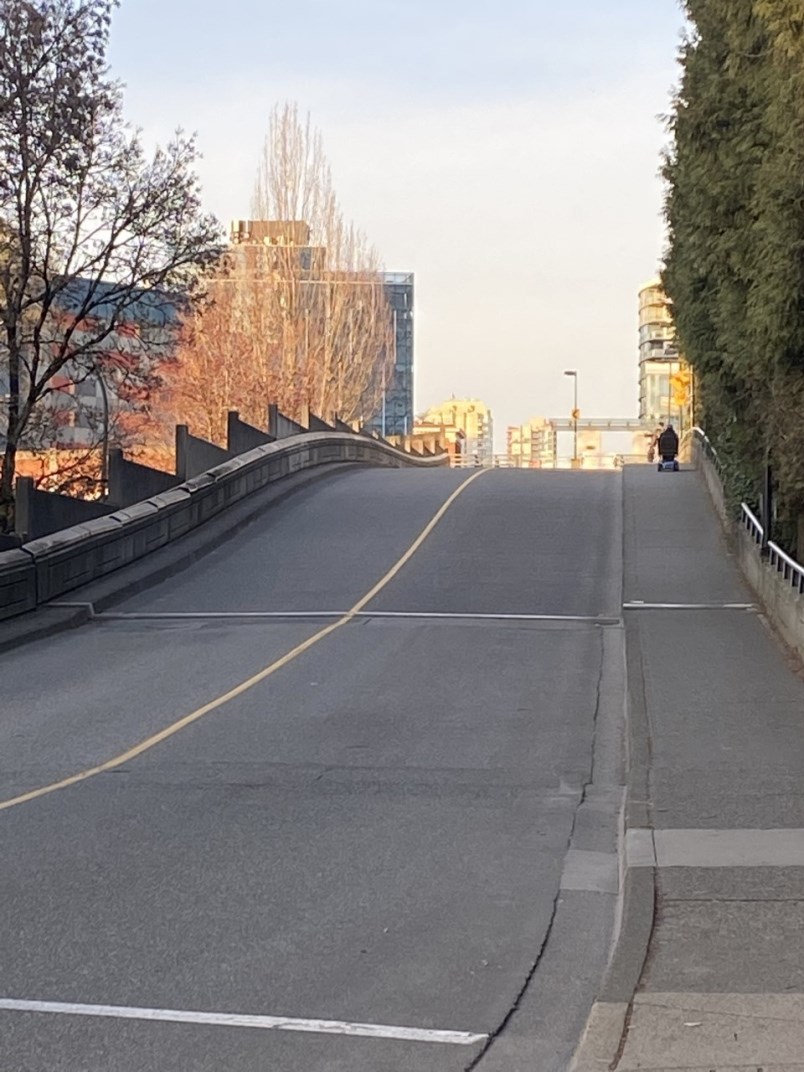The City of New Westminster is planning to reallocate some road lanes normally used by cars to pedestrians to provide better opportunities for physical distancing.
Jim Lowrie, the city’s director of engineering, said staff has been monitoring pedestrian and cycling behavior in response to physical distancing recommendations from health officials. He said the city has received some feedback from community members about concerns at specific locations, including the McInnis overpass, which takes people from Carnarvon Street to Quayside Drive.
“Due to the narrow sidewalk on only one side of the McInnis overpass, we will be removing one vehicle lane in order to provide space for physical distancing of pedestrians and cyclists. This will result in one-way travel in the southbound direction,” he said. “We have directly notified a number of key stakeholders in vicinity of the overpass and Coast Mountain Bus Company, and will issuing public notification early next week.”
When that change is implemented, motorists will leave the Quay via the overpass at Third Avenue or the ground-level crossing at Begbie Street.
Other areas raised as concerns about social distancing include a “pinch point” on the BC Parkway between 14th and 15th avenues, where pedestrians and cyclists have to share a narrow portion of sidewalk. A section of the Central Valley Greenway has also been flagged as a concern.
“We are investigating removing one vehicle lane along North Road in the southbound direction to enable physical distancing on this portion of the Central Valley Greenway,” Lowrie said in an email to the Record. “We are currently collaborating with the City of Burnaby on this.”
Lisa Leblanc, the city’s manager of transportation, said staff is proactively looking at areas where issues may occur.
“We are also proactively scanning the greenway network, commercial areas, sidewalks, in the vicinity of RCH (Royal Columbian Hospital) in particular,” she recently told council. “We have a map of the priority pedestrian network as well, so we are scanning that for pinch points – for areas where the sidewalks might be narrower than what we need to accommodate the volume of pedestrians that we are seeing, and also for cycling. We are actively having a look at the network and responding to suggestions as they come in from the public as well.”
Mayor Jonathan Cote said the city may need to “be a little quicker” at implementing changes.
“Normally these types of changes would require months and months of consultation and discussion but I think we actually need to just bite the bullet and do some of these changes,” he said at the April 6 council meeting. “When we have areas where we are seeing crowding from a pedestrian point of view, we just need to make changes. We know our road usage has gone way down during this crisis. I am hoping in the near future we can actually take action on some of those areas you have identified.”
On Wednesday, HUB Cycling called on Metro Â鶹´«Ã½Ó³»municipalities to install temporary facilities for walking and cycling, using currently under-utilized roadway spaces.
“We need to ensure people have safe spaces to walk and cycle – away from motor vehicles while also allowing social distancing to occur,” said Evan Hammer, infrastructure planning and policy manager at HUB Cycling.
Lowrie said New Westminster is looking at locations where it could use a parking lane or other feature to facilitate the additional space that is required to provide appropriate social distancing for pedestrians and cyclists.
“We are extremely pleased to see the increase in walking and cycling in our community and are currently looking at locations where we can temporarily widen sidewalks and multi-use pathways to make it easier for people to walk and cycle while maintaining appropriate physical distancing,” he said.
Read more from the



